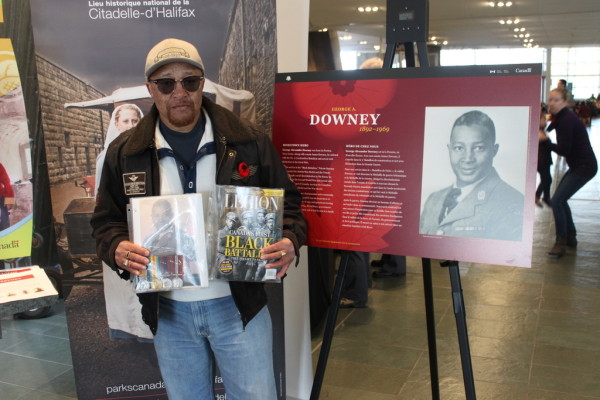11 November 2016
100th anniversary of Canada’s first black militia unit marked at war museum
No. 2 Construction Battalion was founded in 1916

This image from the fall of 1916 shows members of the No. 2 Construction Battalion, Canada’s first military unit made up primarily of black personnel. (Nova Scotia Archives)
The Nova-Scotia based battalion was the first militia unit in Canada made up largely of black personnel. And on this Remembrance Day, their stories was being remembered with a special event at the Canadian War Museum in Ottawa.
The Legacy Voices Project, a group that promotes black veterans, hosted an exhibition this afternoon in the museum’s lobby on both the battalion and other African-Canadian soldiers who served in the First World War.

Legacy Voices leader, Kathy Grant and Sean Foyn examine photos of the No. 2 Construction Battalion, the Nova Scotia-based battalion whose 100th anniversary will be marked today at the Canadian War Museum. (Julie Delaney/CBC)
“There was no official policy that was preventing African-Canadians from joining any of the units that were established across the country,” said Sean Foyn, who wrote his master’s thesis at the University of Ottawa on the No. 2 Construction Battalion.
But because many of the battalions during the early 20th century were “culturally, socially, ethically oriented,” said Foyn — like the Highlanders, for instance — black Canadians who applied to serve were often excluded from those units.
‘We will not have you with us’
“The commanding officer of the unit … if he was a racist, he wasn’t letting you in,” Foyn told CBC Radio’s All In A Day.
“[In] some of the letters which you can find in the national archives, their reasons were quite explicit. You’re black, you’re other words, and we will not have you with us.”

Born in Oklahoma, Columbus Bowen settled in Alberta before joining the No. 2 Construction Battalion, the first Canadian militia unit made up primarily of African-Canadian personnel. (Legacy Voices Project)
Founded in early 1916 in preparation for a major push onto European soil, the No. 2 Construction Battalion, said Foyn, was intended to be made up of the “navvy” class — British slang for manual workers employed on major construction projects like canals and railways.
The Canadian government, however, saw it as an opportunity to find a place for African-Canadians excluded from other units, Foyn said.
Headquartered in Nova Scotia, the battalion drew volunteers from across Canada, the United States and the Caribbean, said Kathy Grant, president of the Legacy Voices Project.
“They had a sense of patriotism to the King,” said Grant. “And also, it was an opportunity for them to be employed. And they thought that if they were to show themselves as fighting men, that they might be better accepted.”
Came back ‘politicized’
The battalion’s primary role was a non-combat one: building roads, clearing trees, maintaining railway tracks and so on.

The official discharge certificate of a member of the No. 2 Construction Battalion who applied to join the unit when he was in his 70s. (Legacy Voices Project)
While its members still found themselves marginalized when they returned to Canada after the war — porters and shoeshiners were some of the only jobs available to them — many came back “more politicized” than when they left, said Grant.
“When they were over there, they were treated as men. And then when they came back, a lot of them were treated as second-class citizens,” Grant said.
Friday’s exhibition at the Canadian War Museum featured medals, photographs and military records from some of the African-Canadian soldiers who fought in the First World War. Descendants of some of the soldiers were also in attendance.
Source: CBC News
Photos copyright Black Ottawa Scene

